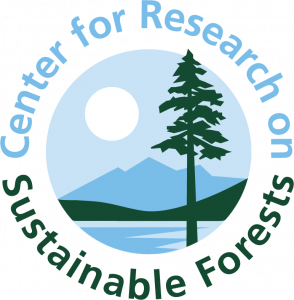Howland Research Forest
 Howland Forest is a forest ecosystem research site established in 1986 by University of Maine researchers with the cooperation of the International Paper Company. It is located approximately 30 miles north of Orono, Maine, and situated within an expansive, low elevation conifer/northern hardwood transitional forest. The forest is dominated by spruce and hemlock with an average stand age of 140 years. The core portion of the research forest, approximately one square mile, surrounds a 100-foot tall walk-up research tower, and was purchased in 2007 by the Northeast Wilderness Trust to preserve the ongoing research and forest.
Howland Forest is a forest ecosystem research site established in 1986 by University of Maine researchers with the cooperation of the International Paper Company. It is located approximately 30 miles north of Orono, Maine, and situated within an expansive, low elevation conifer/northern hardwood transitional forest. The forest is dominated by spruce and hemlock with an average stand age of 140 years. The core portion of the research forest, approximately one square mile, surrounds a 100-foot tall walk-up research tower, and was purchased in 2007 by the Northeast Wilderness Trust to preserve the ongoing research and forest.
Initially funded to conduct biogeochemical cycling and acid rain research, Howland Forest has since been host to various model and sensor development efforts as well as numerous studies focusing on nutrient cycling, forest ecology, ecosystem modeling, acid deposition, remote sensing, climate change, and carbon sequestration. The flat topography and extensive forest make the site ideal for micro-meteorological measurements. With tower and instrumentation infrastructure in place and comprehensive ecological monitoring from below the soil to above the tree canopy, the site continues to attract scientists from around the globe associated with numerous universities, independent research organizations including Woods Hole Research Center, and federal agencies including the USDA Forest Service, NOAA, NASA, EPA, DOE, and DOD.

Already a member of several research networks, Howland Forest became a founding member site of the AmeriFlux network in 1996. The current research focus is on the fluxes of carbon dioxide, methane, water vapor, and energy entering and leaving the forest (i.e., the forest-atmosphere exchange). This, along with the many ancillary ecological and atmospheric data measurement systems, provides valuable information about how forests sequester carbon and interact with the climate system.
Howland Forest is managed by the Environmental Physics group of the University of Maine through the Center for Research on Sustainable Forests, and is currently funded by the Department of Energy through its AmeriFlux program and the USDA Forest Service. For more information on the Howland Research Forest and it’s program, visit the Howland Forest website.
On Wilderness: Rethinking Climate Crisis by David Crews, article with special focus on Howland Forest, published in the environmental literary magazine, The Hopper.
Sean Fraver, NSF-funded Research on Methane Sinks at Howland Forest




